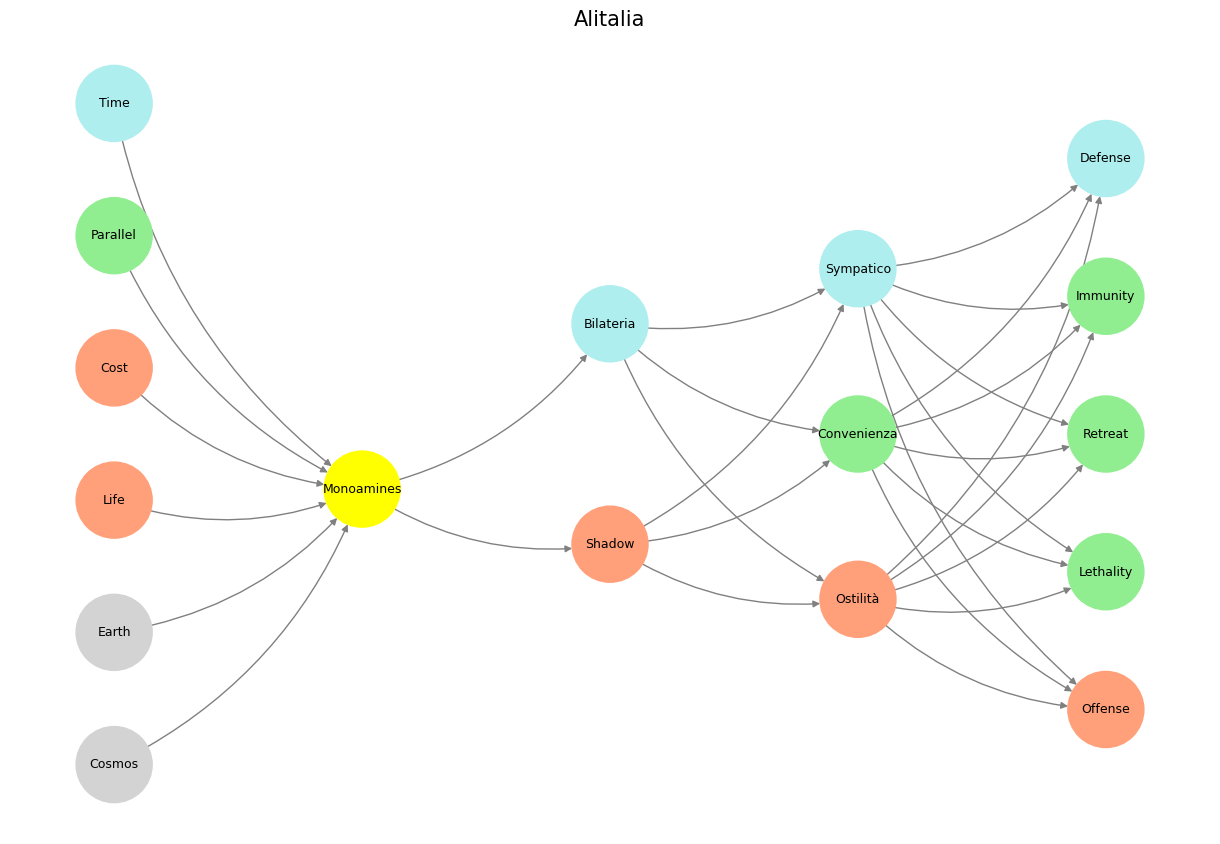Resource#
The human body is a drama in motion, a grand opera where biology plays out its intricate arias on the stage of the nervous system. At the heart of this performance are the presynaptic sympathetic ganglia, pivotal players in the autonomic nervous system. These ganglia act as intermediaries, directing signals with a calculated sense of convenienza, an Italian theatrical term for adapting to context. Depending on the circumstances, they channel the body’s energy toward sympatico—a state of cooperation, harmony, and alignment—or toward ostilità, a mode of defense, confrontation, or aggression. The stakes in this drama are nothing less than survival and adaptation.
The sympathetic nervous system, the protagonist of the fight, flight, and freight trilogy, operates like a vigilant general. When the body perceives a threat, sensory inputs light up the sympathetic ganglia, which then marshal resources for immediate action. Heart rate accelerates, pupils dilate, and glucose floods the bloodstream—a physiological symphony composed for the chaos of battle or escape. In this context, the presynaptic ganglia amplify signals that prepare the body for combat or retreat, embracing ostilità as the dominant mode. Yet, this aggression is not a default stance; it is an adaptation to the circumstances, a calculated shift to maintain the organism’s integrity.
However, the sympathetic ganglia are not always belligerent. The same structures, with remarkable convenienza, can modulate responses to foster sympatico under different conditions. When the context allows for cooperation or alignment—be it social bonding, trust-building, or strategic alliances—the ganglia ease their grip, redirecting the body toward a calmer, more cooperative state. Here, the physiological drama shifts tones: heart rate steadies, blood flow redistributes, and the stage is set for dialogue rather than discord. This duality reveals the ganglia’s capacity to play both sides, embodying the paradox of a system that can alternately stoke the fires of conflict or quench them with harmony.
Against this backdrop, the parasympathetic nervous system emerges as the antagonist—or perhaps the balancing counterpart—in this narrative. It champions the sleep, feed, and breed trilogy, a counterpoint to the sympathetic system’s arias. Where the sympathetic ganglia energize and arouse, the parasympathetic calms and restores, emphasizing homeostasis over heroics. Yet, even within the parasympathetic response, the sympathetic ganglia linger in the shadows, ready to disrupt if the environment demands it. Their presence ensures that even in rest, the organism remains attuned to potential threats, underscoring their role as arbiters of context.
This interplay of sympatico and ostilità is not merely mechanical but deeply emblematic of the human condition. The sympathetic ganglia embody the duality of life’s demands: the need for harmony and connection alongside the imperative for defense and survival. In their capacity for convenienza, these ganglia remind us that adaptation is the essence of existence. The drama of their modulation—directing vibes to align with the cooperative or the adversarial—mirrors the broader tensions of human life, where context dictates whether we extend a hand or clench a fist.
In the grand opera of the nervous system, the presynaptic sympathetic ganglia play their roles with both precision and nuance. Their choices—governed by survival and shaped by context—reveal the elegance of a system designed not just to react, but to adapt. Whether fostering sympatico or embracing ostilità, these ganglia exemplify the art of balancing the tensions that define life, embodying a choreography as ancient as evolution itself. The stakes of this drama are as timeless as the plot: survival, adaptation, and the ceaseless negotiation between harmony and conflict.
Show code cell source
import numpy as np
import matplotlib.pyplot as plt
import networkx as nx
# Define the neural network structure
def define_layers():
return {
'World': ['Cosmos', 'Earth', 'Life', 'Cost', 'Parallel', 'Time', ],
'Perception': ['Monoamines'],
'Agency': ['Shadow', 'Bilateria'],
'Generativity': ['Ostilità', 'Convenienza', 'Sympatico'],
'Physicality': ['Offense', 'Lethality', 'Retreat', 'Immunity', 'Defense']
}
# Assign colors to nodes
def assign_colors():
color_map = {
'yellow': ['Monoamines'],
'paleturquoise': ['Time', 'Bilateria', 'Sympatico', 'Defense'],
'lightgreen': ['Parallel', 'Convenienza', 'Immunity', 'Retreat', 'Lethality'],
'lightsalmon': [
'Cost', 'Life', 'Shadow',
'Ostilità', 'Offense'
],
}
return {node: color for color, nodes in color_map.items() for node in nodes}
# Calculate positions for nodes
def calculate_positions(layer, x_offset):
y_positions = np.linspace(-len(layer) / 2, len(layer) / 2, len(layer))
return [(x_offset, y) for y in y_positions]
# Create and visualize the neural network graph
def visualize_nn():
layers = define_layers()
colors = assign_colors()
G = nx.DiGraph()
pos = {}
node_colors = []
# Add nodes and assign positions
for i, (layer_name, nodes) in enumerate(layers.items()):
positions = calculate_positions(nodes, x_offset=i * 2)
for node, position in zip(nodes, positions):
G.add_node(node, layer=layer_name)
pos[node] = position
node_colors.append(colors.get(node, 'lightgray')) # Default color fallback
# Add edges (automated for consecutive layers)
layer_names = list(layers.keys())
for i in range(len(layer_names) - 1):
source_layer, target_layer = layer_names[i], layer_names[i + 1]
for source in layers[source_layer]:
for target in layers[target_layer]:
G.add_edge(source, target)
# Draw the graph
plt.figure(figsize=(12, 8))
nx.draw(
G, pos, with_labels=True, node_color=node_colors, edge_color='gray',
node_size=3000, font_size=9, connectionstyle="arc3,rad=0.2"
)
plt.title("Alitalia", fontsize=15)
plt.show()
# Run the visualization
visualize_nn()


Fig. 27 In the 2006 movie Apocalypto, a solar eclipse occurs while Jaguar Paw is on the altar. The Maya interpret the eclipse as a sign that the gods are content and will spare the remaining captives. Source: Search Labs | AI Overview#

